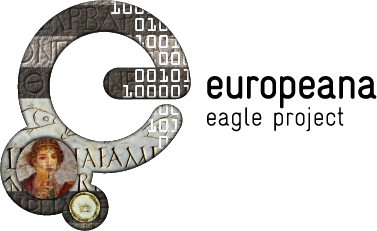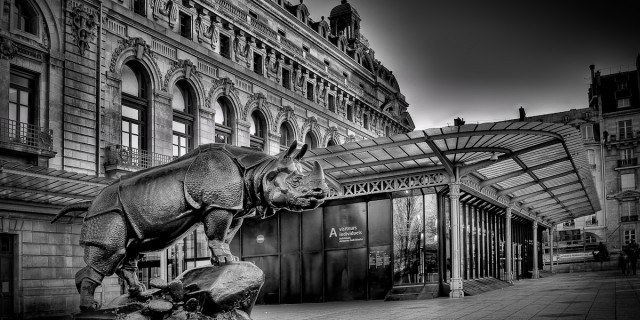EAGLE2014, September 29, 2014
| Ecole Normale Supérieure, 45 Rue d’Ulm, Paris | |
|
|
|
|
14:00 – 14:30 |
Registration & Welcome Coffee |
|
14:30 – 16:00 |
Keynote Address |
|
Eighteen Years of EpiDoc: Now What? |
|
|
Tom Elliott |
|
|
Institute for the Study of the Ancient World |
|
|
Session 1. Harmonizing epigraphic data: tools, models and interactions. |
|
|
Chair: Silvia Orlandi |
|
|
Epigraphy, Art History, Archaeology, Topography in a Roman catacomb. A case of interaction between research projects: the Epigraphic Database Bari (UNIBA, Italy) and the Domitilla Projekt (ÖAW, Austria) Antonio Enrico Felle and Norbert Zimmermann (download presentation) |
|
|
A Conceptual Model for Inscriptions: Harmonizing Digital Epigraphy Data Sources. Vittore Casarosa, Paolo Manghi, Andrea Mannocci, Franco Zoppi and Eydel Rivero Ruiz (download presentation) |
|
|
16:00 – 16:30 |
Coffee Break |
|
16:30 – 18:30 |
Session 1. |
|
Chair: Silvia Evangelisti |
|
|
Between harmonization and peculiarities of scientific domains. Digitizing the epigraphic heritage of pre-Islamic Arabia in the project DASI. Annamaria De Santis, Irene Rossi, Daniele, Marotta and Alessandra Avanzini (download presentation) |
|
|
From the LIMC vocabulary to LOD: Current and Expected Uses of the Multilingual Thesaurus TheA. Anne-Violaine Szabado (download presentation) |
|
|
Improving text-based search of inscriptions. Michelangelo Ceci, Gianvito Pio and Anita Rocco (download presentation) |
|
|
Panel. Digital Humanities Publishing and Collaboration Strategies and Frameworks |
|
|
Panelists: Catherine Dossin, Olivier Marcel, Sorin Matei, Beatrice Joyeux Prunel, Lea |
|
EAGLE2014, September 30, 2014 |
|
|
Ecole Normale Supérieure, 45 Rue d’Ulm, Paris |
|
|
09:00 – 10.30 |
Keynote Address |
|
The aesthetic of the text: the meaning, beauty and the inspiration of the written word (view presentation online) |
|
|
Susan Hazan |
|
|
The Israel Museum |
|
|
Session 2 – Translating epigraphy: challenges and research outcome. |
|
|
Chair: Ulrich Gehn |
|
|
Attic Inscriptions Online: Attic Inscriptions in English Translation. Stephen Lambert and Finlay McCourt (download presentation) |
|
|
One minute Madness. Presentation of poster (visit the digital poster exhibition) |
|
|
10:30 – 11:00 |
Coffee Break & Poster Exhibition |
|
11:00 – 13:00 |
Session 2. Translating epigraphy: challenges and research outcome (continued). |
|
Chair: Ulrich Gehn |
|
|
Towards an EAGLE standard in translating inscriptions. Francesca Bigi (download presentation) |
|
|
The EAGLE MediaWiki. Luca Martinelli, Andrea Zanni, Lorenzo Losa, Pietro De Nicolao and Pietro Liuzzo (download presentation) |
|
|
Translating Greek and Roman inscriptions. Camilla Campedelli (download presentation) |
|
|
PANEL – Linked Ancient World Data. |
|
|
Chair: Faith Lawrence |
|
|
Panelists: Gabriel Bodard, Hugh Cayless, Faith Lawrence, Terhi Nurmikko, Daniel Pett, Ryan Baumann |
|
|
13:00 – 14:00 |
Lunch Break & Poster exhibition |
|
14:00 – 15:30 |
Session 3. Digital approaches to cross-disciplinary studies of inscriptions. |
|
Chair: Francesco Mambrini |
|
|
Latin epigraphic poetry database project (Hispania and Galiae). Concepción Fernández Martínez and María Limón Belén (download presentation) |
|
|
Open-Access Epigraphy: Electronic Dissemination of 3D-digitized Archaeological Material. Eleni Bozia, Angelos Barmpoutis and Robert Wagman |
|
|
The EPNet Project. Production and distribution of food during the Roman Empire: Economics and Political Dynamics. José Remesal, Albert Díaz-Guilera, Bernardo Rondelli, Xavier Rubio, Antonio Aguilera, Daniel Martín-Arroyo, Alessandro Mosca and Guillem Rull |
|
|
Image editing programs as tools for the study of ancient inscriptions. A practical example from the epigraphic dossier of Luna (Italia – regio VII Etruria). Federico Frasson (download presentation) |
|
|
Paleographic analysis of the stone monuments of Aquincum, Pannonia. István Gergő Farkas, Nándor Agócs, Ádám Szabó and Ernő Szabó (download presentation) |
|
|
15:30 – 16:00 |
Coffee Break & Poster Exhibition |
|
16:00 – 18:00 |
Session 3. Digital approaches to cross-disciplinary studies of inscriptions (continued). |
|
Chair: Francisca Feruadi Gruénais |
|
|
Travelling back in time to recapture old texts. The use of Morphological Residual Model (MRM) for epigraphic reading: Four case studies (CIL II 2395a, CIL II 2395c, CIL II 2476, CIL II, 5607) Maria Joao Correia Dos Santos, João Fonte, Luis Gonçalves-Seco, Hugo Pires, Orlando Sousa (download presentation) Morphological Residual Model (MRM) – A tool for enhancing epigraphic readings of highly eroded surfaces. Hugo Pires, João Fonte, Luis Gonçalves-Seco, Maria Joao Correia Dos Santos and Orlando Sousa (download presentation) |
|
|
Digital marmor parium: for a digital edition of a Greek chronicle. Monica Berti and Simona Stoyanova (download presentation) |
|
|
Encoding Codes, Translating Rules, Communicating Stones in Ptolemaic Cyrene and Contemporary Bologna. Alice Bencivenni and Simone Agrimonti (download presentation) |
|
|
PANEL. Technology and tradition: a synergic approach to deciphering,analyzing and annotating epigraphic writings |
|
|
Chair: Federico Boschetti |
|
|
Panelists: Angelos Barmpoutis, Federico Boschetti, Eleni Bozia, Matteo Dellepiane, Marion Lamé, Stéphane Polis, Serge Rosmorduc, Giulia Sarullo |
|
|
18:00-19:00 |
Poster Exhibition |
EAGLE2014, October 1, 2014 |
|
|
Collège de France, 11 Place Marcellin Berthelot, Paris |
|
|
08:30 – 09.00 |
Registration & Coffee |
|
09:00 – 10.30 |
Session 3. Digital approaches to cross-disciplinary studies of inscriptions (continued). |
|
Chair: Valentina Vassallo |
|
|
THE INSCRIPTION BETWEEN TEXT AND OBJECT The deconstruction of a multifaceted notion with a view of a flexible digital representation. Eleonora Santin, Emmanuelle Morlock |
|
|
The music in the inscription – A multi-layered research on an ancient Cypriot Inscription. Valentina Vassallo, Sorin Hermon, Michalis Geōrgiou, Spyros Armostis, Elena Christophorou (download presentation) |
|
|
Epigraphy – Who cares? Meeting today’s needs of epigraphy’s audiences in digital editions. Laura Löser (download presentation) |
|
|
EAGLE MEDIAWIKI Edit-a-thon. Hands-on presentation. Andrea Zanni, Pietro Liuzzo, Luca Martinelli |
|
|
Session 4. Who cares? Users, epigraphy and the social web. |
|
|
Chair: Raffaella Santucci |
|
|
Digital Invasions. A bottom-up crowd example of cultural value co-creation. Marianna Marcucci, Fabrizio Todisco and Elisa Bonacini (download presentation) |
|
|
Svegliamuseo: a project to “wake up” Italian museums online. Francesca De Gottardo, Valeria Gasparotti, Alessandro D’Amore and Aurora Raimondi Cominesi (download presentation) |
|
|
Archeowiki: when open-source strategies attract visitors’ presence in museums. A project for the enhancement of archaeological heritage in Lombardy (Italy). Sara Chiesa, Anna Antonini, Sara Franco, Dante Bartoli, Cristian Consonni, Rossella di Marco (download presentation) |
|
|
10:30 – 11:00 |
Coffe Break & Poster Exhibition |
|
11:00 – 13:00 |
Session 4. Who cares? Users, epigraphy and the social web (continued). |
|
Chair: Enrico Antonio Felle |
|
|
The Ashmolean Latin Inscriptions Project (AshLI): Bringing epigraphic research to museum visitors and schools. Jane Masseglia (download presentation) |
|
|
Epigraphs Visual Recognition. Giuseppe Amato, Fabrizio Falchi, Fausto Rabitti, Lucia Vadicamo (download presentation) |
|
|
PANEL. Mobile Applications in Cultural Heritage. |
|
|
Chair: Vittore Casarosa |
|
|
Panelists: Giuseppe Amato, Susan Hazan, Sorin Hermon, Philippe Martineau, Franco Niccolucci, Andrea Zanni |
|
|
13:00 – 14:00 |
Lunch & Poster Exhibition |
|
14:00-16:15 |
Session 4. Who cares? Users, epigraphy and the social web (continued). |
|
Chair: Christian Uhlir |
|
|
(Digital) epigraphy as viewed by Romanian Archaeology/Classics students. Rada Varga (download presentation) |
|
|
Epigraphy as a tool for learning Latin – The case of the Prežihov Voranc Primary School in Ljubljana, Slovenia. Anja Ragolic (download presentation) |
|
|
PANEL. Dealing with the Whole Object: the Archaeological Dimension of Epigraphy. |
|
|
Chair: John Bodel |
|
|
Panelists: Marie-Claire Beaulieu, John Bodel, Michele Brunet |
|
|
Wrap Up & Conclusions. Silvia Orlandi |
|
|
16:15-18:00 |
EAGLE MEDIAWIKI Edit-a-thon |
|
Posters & Demo |
|
|
From CIL to GIS: Exploring Pompeian Inscriptions through an Integrated 2D-3D Approach |
|
|
Karin Lundqvist and Giacomo Landeschi |
|
|
BILG – Inscriptiones Graecae et Latinae Bruttiorum. A digital corpus in EpiDoc of Roman Law inscriptions |
|
|
Daria Spampinato |
|
|
From Stone to Screen: Digitizing Epigraphic Squeezes |
|
|
Maude Côté-Landry, Haley Bertram, Lisa Tweten and Chelsea Gardner |
|
|
Sicily: A digital corpus of inscriptions from ancient Sicily |
|
|
Jonathan Prag |
|
|
The first (social) time The Archeological National Museum of Cagliari 2.0 |
|
|
Anna Maria Marras |
|
|
Geographic Information System-A suitable bridge between Epigraphy and Archeology |
|
|
Elisa Orlando |
|
|
The Herculaneum Graffiti Project: Reenvisioning the Ancient City |
|
|
Rebecca Benefiel and Sara Sprenkle |
|
|
IPR Tools for Content Aggregators |
|
|
Pierfrancesco Bellini, Paolo Nesi and Michela Paolucci |
|
|
Free, Open and Mobile. An open platform solution changes the rules of the game into museums. |
|
|
Alex Palin, Alex Tourski, Stefania Chipa |
|
|
Géza Alföldy on the facebook. Popularyzing ancient history and epigraphy: future perspectives |
|
|
Csaba Szabó |
|
|
MINIMA EPIGRAPHICA: PROJECT SCRITTURA SU ARGILLA E CERAMICA. Everyday Writing in the Phoenician-Punic West |
|
|
Paola Cavaliere,Danila Piacentini and Massimiliano Vassalli |
|
|
DATABASE OF EGYPTIAN SED-FESTIVAL & RITUAL TEXTS AND SCENES (DESERTS) |
|
|
Julie Masquelier-Loorius and Mélanie Flossmann-Schütze |
|
|
E-STAMPAGES Project: Towards a Digital Library of Squeezes |
|
|
Adeline Levivier |
|
|
Best Practices of an Amateur Epigrapher: One Woman’s Experience with an Epigraphy Database |
|
|
Amanda Kelley |
|
|
The Nani Museum:Towards the Virtual Reconstruction of a Dispersed Epigraphic Collection |
|
|
Lorenzo Calvelli, Francesca Crema and Franco Luciani |
|
|
Promotion of Ancient Heritage on Social Networks (Example of Croatian Regions Istria and Dalmatia) |
|
|
Valentina Zović and MarinaZgrablić |
|
|
Flickr and Epigraphy. Description of an experience |
|
|
Fabio Paglia |
|
|
IPR issues. The British School a Rome: a case study |
|
|
Alessandra Giovenco |
|
|
DIGITALMEETSCULTURE.NET – Interactive e-zine where digital technology and culture collide |
|
|
Valentina Bachi, Manuele Buono, Antonella Fresa, Tania Masi, Claudia Pierotti and ClaudioPrandoni |
|
|
Low-cost structure from motion technology. An open approach for epigraphical digital reconstruction |
|
|
Anita Rocco,Daniele Mittica, Michele Pellegrino |
|
|
INSCRIPTIONES CHRISTIANAE ASIAE MINORIS / GRAECIAE |
|
|
C. Breytenback, K.Hallof, U. Huttner, E. Sironen, C. Zimmerman, J. Ogereau, M. Veksina, J. Krumm |
|
|
The EPNet Project. Production and distribution of food during the Roman Empire: Economics and Political Dynamics |
|
|
José Remesal, Albert Díaz-Guilera, Bernardo Rondelli, Xavier Rubio, Antonio Aguilera, Daniel Martín-Arroyo, Alessandro Mosca, Guillem Rull |
|
|
RICHES Project: Recalibrating Relationships |
|
|
www.riches-project.eu |
|
|
PREFORMA Project: Future Memory Standards |
|
|
www.preforma-project.eu |
|
|
Europeana Space: Spaces of possibility for the creative re-use of digital cultural content |
|
|
www.europeana-space.eu |
|
|
Civic Epistemologies: A Roadmap for Citizen Researchers in the age of Digital Culture |
|
|
www.civic-epistemologies.eu |
|
|
EAGLE MEDIAWIKI -Editathon (hands-on session) |
|
|
Andrea Zanni,Pietro Liuzzo, Luca Martinelli |
|
|
Romans Go Home: Latin and Greek apps for iPhone, iPad and Android (demo) |
|
|
Paul Hudson |
|

